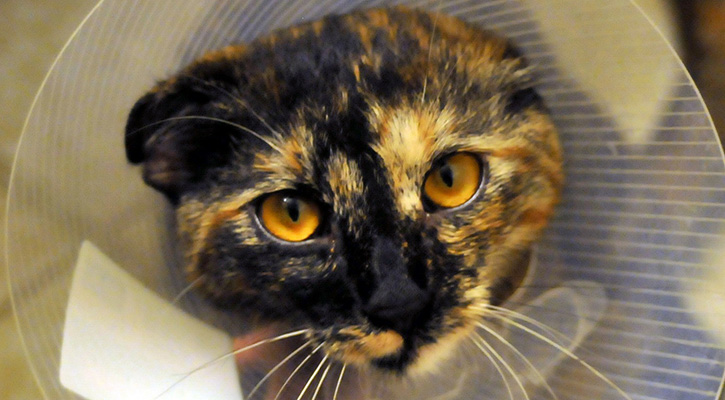
Cat Laparoscopic Surgery
In comparison to traditional surgery, laparoscopic surgery for cats is a minimally invasive alternative and typically results in a shorter recovery time. Similar to arthroscopic surgery, your veterinarian will make one or two small openings in the cat’s abdomen and insert both a camera and the surgical tools required to complete the procedure. This allows our veterinarians to visualize the organs and the abdominal cavity through what is called a “keyhole”, perform the operation and exit the body without creating incisions that are any larger than absolutely necessary.
This type of surgery is typically used for spaying cats, or to perform a biopsy of the liver or intestines. Should your veterinarian need to take several samples, laparoscopic surgery is the safest and the least invasive way to collect samples for a diagnosis. Laparoscopic surgery is also used to view the abdominal cavity for any abnormalities. Since it is minimally invasive, cats will typically experience less pain and a quicker healing time.
Benefits of Laparoscopic Surgery
There are benefits to using laparoscopic surgery whenever it is possible, such as:
- Smaller incision
- Less invasive
- Quicker recovery
- Shorter procedure time
Types of Surgeries Where Laparoscopy Is Used
Laparoscopy is commonly used in our veterinary practice for spaying cats and taking ovarian biopsies. Laparoscopy can also be used for other types of biopsies such as:
- Liver biopsy
- Tumor biopsy
- Intestinal biopsy
- Kidney biopsy
Preparing Your Cat for A Laparoscopy
In order to prepare your cat for a laparoscopy, you should follow your veterinarian’s instructions.
- Fasting your cat the night before is typically recommended.
- Allow your cat to drink water to stay hydrated until the morning of the surgery.
- Arrive on time for the surgery, and be sure to address any questions or concerns you may have.
What Happens When The Procedure Is Over?
Typically, your cat will recover from the anesthesia in your veterinarian’s recovery area. You will then be given a set of instructions for your cat’s care and be sent home with your cat to rest and recover.
Caring For Your Cat At Home After Laparoscopic Surgery
Follow the instructions that your veterinarian gives you. Home care instructions will vary depending upon what type of surgery has been performed. Generally, your cat should recover in 12-24 hours after the laparoscopy surgery. If your cat shows any signs of distress, call us immediately at Vida Veterinary Care, and we will give you instructions on how to handle this situation.
Don’t encourage any strenuous activity for a couple of days. Keep your cat quiet, monitor their activity, and keep them indoors for a few days. Each and every patient is different and is dealing with a different recovery based on the procedure, so we strongly recommend that you follow the personalized instructions our veterinarian provides for your cat.
Contact Us About Laparoscopic Surgery For Your Cat
If you are looking into less invasive surgical options for your cat, please call us at Vida Veterinary Care and talk to a veterinarian about the benefits of laparoscopic surgery for cats.
You can call our Denver office at 303-757-5638 or our Centennial office at 303-843-7222 for more information or for a consultation for your cat.
Explore Our Complete List of Veterinary Services in Denver, CO & Centennial, CO
- Senior Cat Care
- Kitten Care
- Cat Vaccinations
- Cat Surgery
- Cat Spaying & Neutering
- Cat Nutrition
- Cat Microchipping
- Cat Laser Therapy
- Cat Lab Tests
- Cat Diagnostic Imaging
- Cat Dental
- Cat Cardiology
- Cat Cancer
- Anesthesia & Patient Monitoring
- Puppy Care
- Dog Lab Tests
- Heartworm Prevention
- Parasite Prevention
- Cancer Referrals
- Dentistry
- Wellness Care for Cats
- Wellness Care for Dogs
- Dog Laser Therapy
- Acupuncture
- Dog Spay & Neuter
- Dog Vaccinations
- Exotic and Avian Care
- Dog Dental Care
- Dog Nutrition
- Dog Surgery
- Digital Radiology
- Dog Diagnostic Imaging
- Senior Dog Care
- Dog Microchipping
- Emergency Veterinary Care
